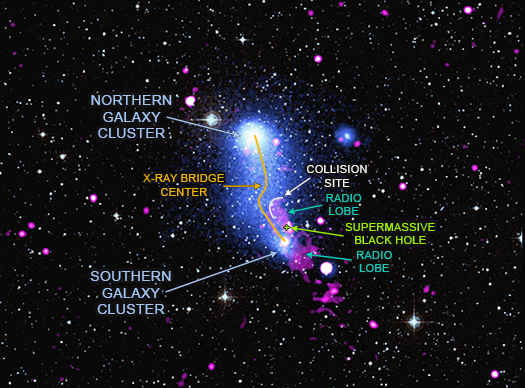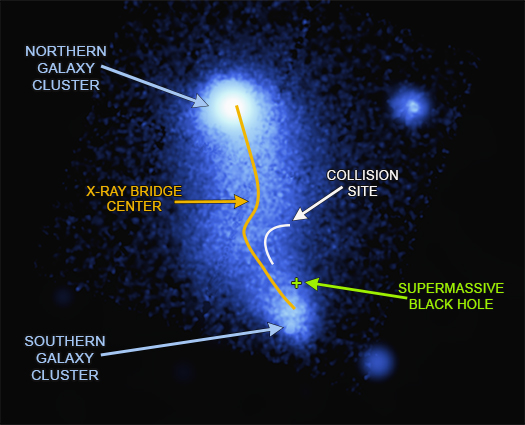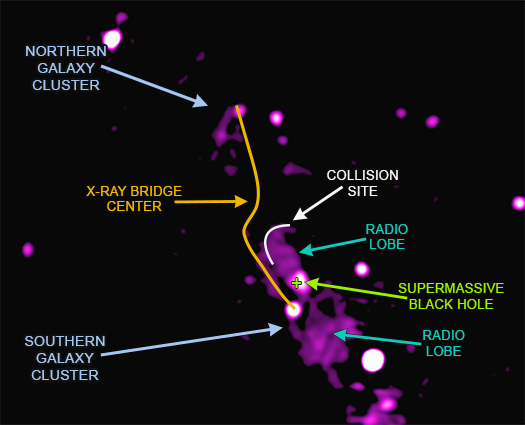Bending the Bridge Between Two Galaxy Clusters
Several hundred million years ago, two galaxy clusters collided and then passed through each other. This mighty event released a flood of hot gas from each galaxy cluster that formed an unusual bridge between the two objects. This bridge is now being pummeled by particles driven away from a supermassive black hole.
Galaxy clusters are the largest objects in the universe held together by gravity. They contain hundreds or thousands of galaxies, vast amounts of multi-million-degree gas that glow in X-rays, and enormous reservoirs of unseen dark matter.
The system known as Abell 2384 shows the giant structures that can result when two galaxy clusters collide. A superheated gas bridge in Abell 2384 is shown in this composite image of X-rays from NASA's Chandra X-ray Observatory and ESA's XMM-Newton (blue), as well as the Giant Metrewave Radio Telescope in India (red). This new multi-wavelength view reveals the effects of a jet shooting away from a supermassive black hole in the center of a galaxy in one of the clusters. The jet is so powerful that it is bending the shape of the gas bridge, which extends for over 3 million light years and has the mass of about 6 trillion Suns.
A labeled version of the image traces the shape of the bridge, marks the position of the supermassive black hole, and shows where the jet is pushing the hot gas in the bridge sideways at the collision site. The lobe of radio emission marking the end of each jet is also shown. At the collision site, astronomers found evidence for a shock front, similar to a sonic boom from a supersonic aircraft, which can keep the gas hot and prevent it from cooling to form new stars.
The radio emission extends about 1.2 million light years from the black hole to the north and about 1.7 million light years to the south. The northern radio emission is also fainter than the southern emission. These differences might be explained by the radio emission to the north being slowed down by the jet's impact with the hot gas in the bridge.
Chandra has often observed cavities in hot gas created by jets in the centers of galaxy clusters, such as the Perseus cluster, MS 0735 and the Ophiuchus Cluster. However, Abell 2384 offers a rare case of such an interaction occurring in the outer region of a cluster. It is also unusual that the supermassive black hole driving the jet is not in the largest galaxy located in the center of the cluster.
Astronomers consider objects like Abell 2384 to be important for understanding the growth of galaxy clusters. Based on computer simulations, it has been shown that after a collision between two galaxy clusters, they oscillate like a pendulum and pass through each other several times before merging to form a larger cluster. Based on these simulations, astronomers think that the two clusters in Abell 2384 will eventually merge.
Abell 2384 is located 1.2 billion light years from Earth. Based on previous work, scientists estimate the total mass of Abell 2384 is 260 trillion times the mass of the Sun. This includes the dark matter, hot gas and the individual galaxies.
A paper describing this work was published in the January 2020 issue of the Monthly Notices of the Royal Astronomical Society, and is available online. The authors are Viral Parekh (South African Radio Astronomy Observatory and Rhodes University, South Africa); Tatiana Lagana (Universidade Cruzeiro do Sul/Universidade Cidade de São Paulo, Brazil); Kshitij Thorat (Rhodes University); Kurt van der Heyden (University of Cape Town, South Africa); Asif Iqbal Ahanger (Raman Research Institute, India); and Florence Durret (Institut d'Astrophysique de Paris and Sorbonne Université, France).
Category:
- Log in to post comments



